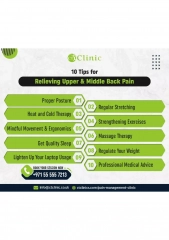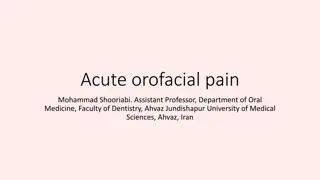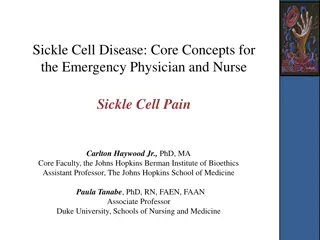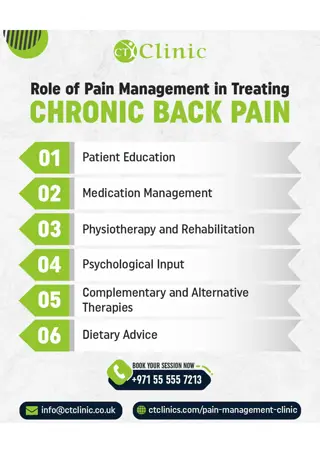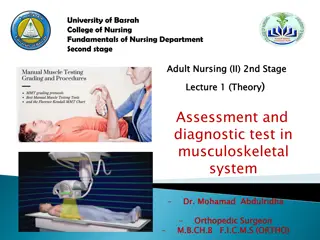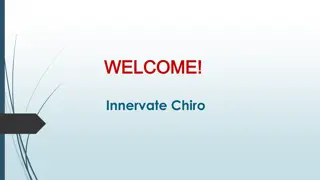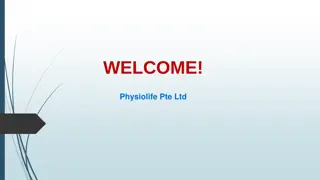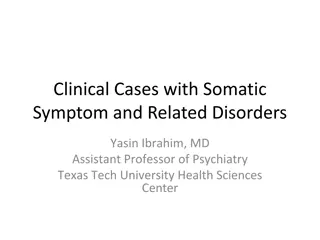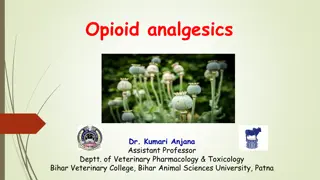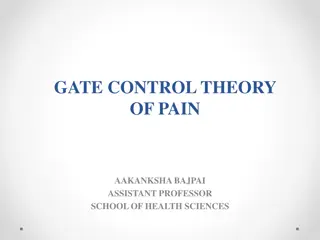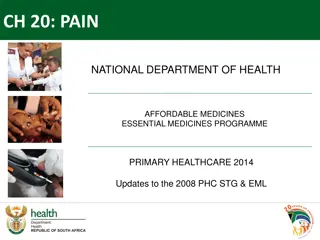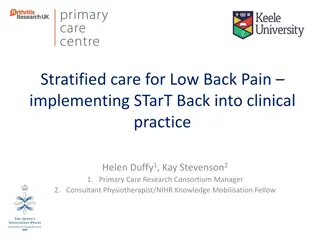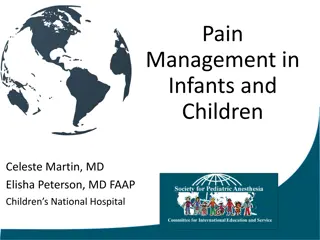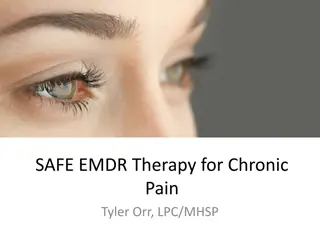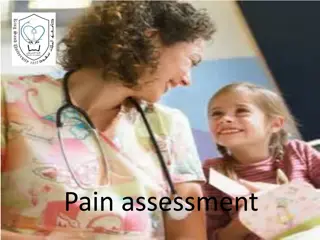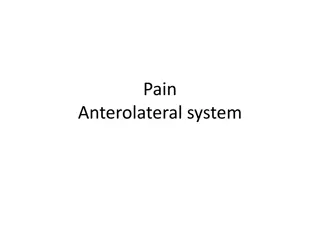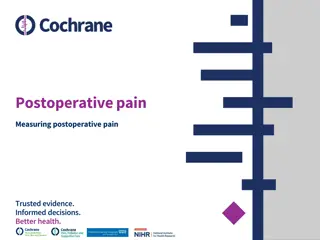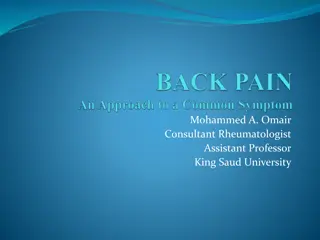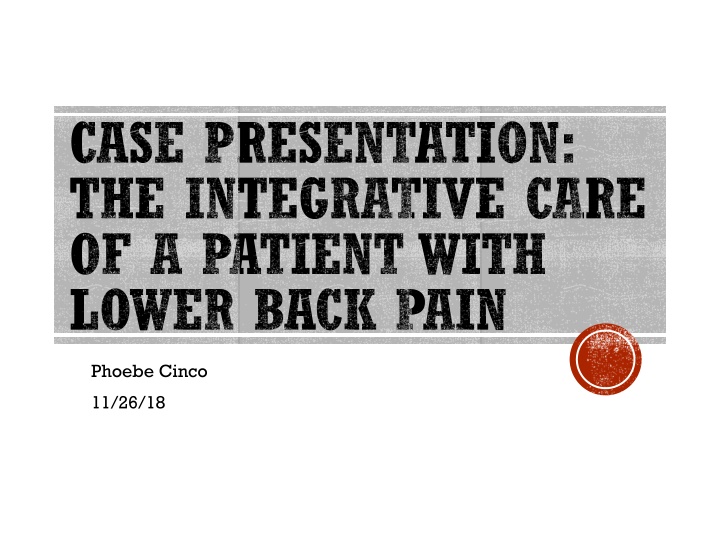
Integrative Care for Chronic Lower Back Pain: A Case Presentation
Explore the comprehensive approach to managing chronic lower back pain in a 34-year-old Hispanic female through an integrative care plan. Understand the pathophysiology, epidemiology, risk factors, and evidence-based complementary and alternative medicine (CAM) interventions for this condition. Dive into the patient's history, symptoms, treatments, and outcomes to gain valuable insights into addressing chronic muscular back pain.
Download Presentation

Please find below an Image/Link to download the presentation.
The content on the website is provided AS IS for your information and personal use only. It may not be sold, licensed, or shared on other websites without obtaining consent from the author. If you encounter any issues during the download, it is possible that the publisher has removed the file from their server.
You are allowed to download the files provided on this website for personal or commercial use, subject to the condition that they are used lawfully. All files are the property of their respective owners.
The content on the website is provided AS IS for your information and personal use only. It may not be sold, licensed, or shared on other websites without obtaining consent from the author.
E N D
Presentation Transcript
CASE PRESENTATION: THE INTEGRATIVE CARE OF A PATIENT WITH LOWER BACK PAIN Phoebe Cinco 11/26/18
OBJECTIVES After attending this case presentation, participants will be able to: Explain the pathophysiology of chronic muscular back pain Describe the Epidemiology of chronic muscular back pain Identify the risk factor of chronic muscular back pain Evaluate evidence-based CAM into the plan of care for patient diagnosed with chronic back pain Analyze a case presentation of a 34 years old female diagnosed with chronic back pain.
PATIENT A 34 year old Hispanic female c/o chronic back pain x5 years. HPI: She is c/o lower back pain for approximately 5 years. Her back pain was a slow onset but is progressively getting worst. Aggravating factors are sitting for a long period of time and bad posture. At night pain is worst. Alleviating factors are when she moves around and moderate relief with NSAIDs. She is a nurse. Her occupation requires a lot of bending over, lifting, and pushing to perform task. She work a 12 hour shift. Pain worsening at the end of her shift. She denies of injuries or trauma.
History: Alleriges: NKDA, no food or environmental allergies Medical Hx: allergic rhinitis, chronic low back pain Surgical Hx: none OB: G0, LMP, 11/03/2018 Family Hx: Father unknown hx of father s side Mother: HTN Siblings none Medications: She has attempted tylenol 1000 mg as needed alternating with Ibuprofen 600mg as needed CAM: -She has tried and currently using belt back support, warm packs, massage, gel patches, TENS -She is exercising x2 a week -She is currently under care of chiropractic treatment
ROS Constitutional: Denies: fever, night sweats, significant weight gain or weight loss exercise intolerance, malaise, chills. Neurologic/Head: Denies loss of consciousness, weakness, numbness, dizziness, headaches, or tremors. Eyes: Denies vision changes, eyes pain, or irritation Ears: Denies hearing changes, pain or tinnitus. Nose: Denies nosebleeds, drainage, nasal congestion Mouth/Throat: Denies mouth or throat pain and difficulty swallowing. Cardiovascular: Denies chest pain, pressure, or palpitation Respiratory: Denies of cough and shortness of breath GI/GU: Denies abdominal pain, nausea, vomiting, diarrhea, constipation, dysuria or incontinence. Musculoskeletal: Positive for lower back pain Integument: Denies of rashes, laceration, non-healing wounds, Psychiatric: Denies depression, SI/HI Hematologic: Denies bleeding or bruising
PHYSICAL EXAM General: Well groomed. Sitting in position of comfort Skin: PWD, no pallor Head: Normocephalic, atraumatic Eyes: PERRLA, conjunctivae pink, EOMI, no ptosis or nystagmus Ear: canals clear, TMs & bone landmarks normal, hearing normal. Nares: atraumatic, patent. Throat/Mouth: MMM, normal rise of soft palate, posterior pharynx clear, tonsil 1+ without erythema or discharge Neck: Supple, FROM, no lymphadenopathy or meningismus, trachea midline Chest/Resp: CTA, RRR, no murmur, rub, or gallop Abd: soft, BSA, NT Musculoskeletal: Thoracolumbar tenderness with deep palpation but with FROM. Moves all extremities with good strength 5/5, distal motor/sensory intact and symmetrical, no spinal or CVA tenderness, good pulses. Neuro: A/O x4, GCS 15, CNII-XII intact, no focal neuro deficits.
ASSESSMENT Diagnosis: Chronic lower back pain (M54.5) Differential Diagnosis: Spinal Stenosis, Radiculopathy, Spinal neoplasia, Pyelonephritis, Spinal neoplasia. Medication: Continue with NSAIDs and acetaminophen Take with food to decrease stomach upset Diagnostic: CBC, CMP, UA, HCG quantitative, XR thoracic and lumbar 2 views. Plan: Obtain labs. May continue using heat packs, exercise and chiropractic care Referral to Physical Therapy Educate: Lifestyle modifications such as good posture Suggested other non pharmaceutical therapies (accupunture, massage, and yoga).
EPIDIMEOLOGY Most adults will experience back pain once. It is the fifth most common reason for primary visit Annual cost estimated $86 billion The World Health Association (WHO) declared Low back pain 6th most burdensome condition in 2010 Back pain is the top morbidity in the Unite States. Back pain is the leading opioid prescription for noncancerous pain
ETIOLOGY/PATHOPHYSIOLOGY Acute low back pain is pain occurring less than 6 weeks of duration in the lumbosacral region. Chronic low back pain is pain lasting more than 3 months Causes of back pain: disk herniation, radiculopathy, spinal stenosis, osteoporosis. Referred pain from visceral pain, pelvic or gastrointestinal diseases. The back pain may emanate from facet joints, ligaments, fascia, vertebral periosteum, nerve roots, or muscle. In the Chinese tradition, the cause of the back pain is due to a blockage in the flow of qi and imbalance of yin and yang.
RISK FACTORS Age Lack of exercise Excess weight Improper body mechanics Psychological conditions Diseases Injuries Keene Start Tool:
SIGN AND SYMPTOMS Muscle ache Shooting or stabbing pain Pain that radiates down the legs Pain worsens with movement: bending, walking, etc.
TREATMENTS 1st line: Acetaminophen and NSAIDs are the fist line pharmaceutical treatment for back pain recommended by World Health Organization. Acetaminophen has the fewest side effects. While NSAIDs have fewer side effects compared to second line medications (opiods/muscle relaxants) 2nd line: Opiods & Muscle Relaxants -On average opiod resulted in a small pain relief and causes less functional improvement than other analgesics. -Some patients, opiods may even cause hyper analgesia S/E: lowers testosterone in men, constipation
TREATMENTS Skeletal Muscle Relexants An older systematic review found that muscle relaxants are on effective on short-term pain relief and not effective on chronic back pain. S/E (dizziness, sedation) Tricyclic Antidepressants -Recommended as an adjunctive treatment -Additional benefits as a sleep aid. S/E: sleepiness.
BOTANICALS & SUPPLEMENTS Devils claw: common use treatment for pain but not inferior to NSAIDs. May be used before NSAID treatment. Willow Bark: contains Salicin related to aspirin but w/o effecting GI mucosa or blood clotting. Vitamin D: A correlation with low vitamin D and chronic back pain. Evidence showed Vitamin D supplements improved quality of life, sleep, and, pain. Topical Capsaicin: for short-term analgesics.
BIOMECHANICAL INTERVENTIONS Exercise therapy: Increase activity, strength muscle tone. Evidence show higher exercise intensity the better pain control. Spinal Manipulation: Stimulates cascade of central and peripheral events resulting in pain relief. -The only nonpharmacological therapy recommended by American Pain Society for acute lower back pain. Massage: Recommended for subacute and chronic back pain. There is a higher pain relief in conjunction with exercise. Yoga: Addresses physical, mental, emotional, and spiritual components. Yoga is moderately effective in chronic low back pain that improves back function and reduces pain. Tai Chi: low impact exercise that may reduce back pain. Recommended for sedentary or elderly individuals. Evidence shown it improves balance.
BIOMECHANICAL INTERVENTIONS Acupuncture: A Traditional Chinese Medicine (TCM) that uses needles to stimulate endorphins and alters pain sensation. Research concluded multiple chemicals released (interleukins, substance P, and adenosine) attributed to acupuncture analgesia.
RETURN TO THE PATIENT: THE PLAN What did you try - The plans that was listed and discussed What worked - The chiropractic treatment with acupuncture along with NSAIDs What didn t work - Physical therapy Current Plan - Continue with chiropractic, acupuncture and NSAIDs - Practice daily good posture and body mechanics Future Plan - Add yoga in the regimen
SUMMARY Back pain is the top reason for morbidity in United States The first line pharmaceutical therapy are NSAIDs and acetaminophen Treatment such as acupuncture in conjunction with NSAIDs, exercise, chiropractic treatment can lead to better pain relief Botanicals such as Willows bark and Devils claw can help alleviate pain
REFERENCE Keele University (2018). Start back tool. Retrieved from https://www.keele.ac.uk/sbst/startbacktool/ Rakel, D. (2018) Integrative medicine (4th Ed.). Elsevier Saunders: Philadelphia.

